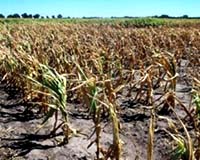| . |  |
. |
Nanyuki, Kenya (AFP) Aug 19, 2009 In Kenya a bruising and recurring drought is driving huge numbers of subsistence farmers away from rural areas, where they are increasingly reliant on hand-outs, into congested slums. "People are opting to relocate. I know families that are demolishing their houses, selling iron sheets and timber and getting back to the nearest towns and settling in slums," said Steven Waweru, an official with Caritas that helps distribute World Food Programme aid in the region. "In this village, about 50 percent of people have moved to the slum areas. This is going to increase pressure in town," he said, adding: "We've not seen that for a long long time". "We see a very, very bad scenario in the next six months if no rains come down." Officials point soberly to the consequences of this mass exodus to the towns. "Obviously the crime rate is going to rise in the towns -- prostitution and child labour are on the increase because people are looking for anything to get a shilling or two to buy food that is very expensive these days," Waweru said. Lucy Gathigia Mahinda, a farmer of 52, has held out so far. She is still on her land but is reduced to receiving food aid and even with that can only feed her seven children once a day. That meal consists of corn donated by the UN food agency, washed down with tea. She is deeply ashamed of her reliance on aid, but recognises that after four failed rainy seasons, she has no option. "It's shameful and a bit degrading for a strong person with land to continue lining up and begging for food to survive. I have no choice at the moment," she told AFP in Nyariginu village in Laikipia district. In this district, traditionally one of the country's bread baskets, 190 kilometres (118 miles) north of Nairobi, fields of dead corn give way to arid plains where no livestock graze. The WFP now estimates 3.8 million Kenyans, or one tenth of the country's population are in need of emergency food aid. The spectre of the 2000 drought, Kenya's worst in 37 years, is rearing its head. Like her neighbours, Mahinda cultivates mainly corn: on her two-acre (0.8 hectare) patch. In a good year she gets 20 90-kilogramme bags of cereal. This year a sprinkling of weak corn plants struggle to stay upright. The only option now to wait for the next short rains, due in October, and to hope they will enable a decent harvest in 2010. The future of Mahinda and that of her fellow villagers, depends not only on the rains that are due but also on their ability to buy new seed and fertilizer. Livestock has also been hit hard. Mahinda lost her four cows. Her neighbour Paul Maina lost four cows and eight goats. Most pastoralists have taken their animals up into the foothills of Mount Kenya in search of high-altitude pasture land. Those with larger numbers of livestock drove their animals up into the foothills of Mount Kenya in search of fresh pastures several months ago. But the animals are also dying in large numbers up there -- from exhaustion, disease and pneumonia, given the low night temperatures. Dozens of rotting animal carcasses pile up among the pine trees. "The livestock still hasn't recovered from the 2005 drought. And already we have to confront a new drought. The drought cycle is getting shorter and shorter - every three or four years instead of every 10," a district veterinary official told AFP. Many of Mahinda's farmer neighbours have already abandoned the land, at least temporarily, in favour of producing and selling charcoal or breaking stones in a nearby quarry for a local construction company. The work is both back-breaking and ill-paid. A 20-litre jerrycan of ballast is paid five shillings (six US cents). A one-kilo bag of flour costs 45 shillings (58 US cents). So even a hardened "stone breaker" has to work around nine hours to buy a kilo of flour. Share This Article With Planet Earth
Related Links Climate Science News - Modeling, Mitigation Adaptation
 India faces drought but economists upbeat
India faces drought but economists upbeatNew Delhi (AFP) Aug 16, 2009 Crops are shrivelling as India faces the spectre of drought but economists say they are still upbeat about the country's economic prospects. They are banking that a strong industrial performance will help offset the impact of the worst monsoon in years in Asia's third largest economy. Analysts have been buoyed by new data showing industrial production jumped by 7.8 percent in June from ... read more |
|
| The content herein, unless otherwise known to be public domain, are Copyright 1995-2009 - SpaceDaily. AFP and UPI Wire Stories are copyright Agence France-Presse and United Press International. ESA Portal Reports are copyright European Space Agency. All NASA sourced material is public domain. Additional copyrights may apply in whole or part to other bona fide parties. Advertising does not imply endorsement,agreement or approval of any opinions, statements or information provided by SpaceDaily on any Web page published or hosted by SpaceDaily. Privacy Statement |